|
|
|
 |
|
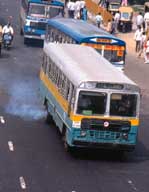 |
THREE
years ago (July 28, 1998), the Supreme Court (SC) ruled that
the total passenger bus fleet of Delhi be increased from the
then figure of about 6,000 to 10,000 by April 1, 2001 and
the entire city bus fleet be converted to CNG. The objective
was to expand the city's public transport system and also
to control pollution. Incremental steps to bring in only new
buses on CNG would have taken over a decade to arrest the
pollution in the world's most polluted city. Not only were
diesel buses contributing heavily to particulate pollution,
the city also had possibly the highest bus density in the
world. And it continues to grow rapidly with more and more
vehicles hitting the roads. To deal with pollution from petrol-driven
vehicles, the SC ordered the exclusive sale of unleaded and
low benzene petrol and advanced improved Euro II vehicular
standards by almost five years.
|
|
|
By
August 2001, Delhi had the largest fleet of CNG buses in the world.
There were 2,394 buses, over 27,000 autos and 14,000 other vehicles
running on CNG. But without adequate supply of gas, the future of
these vehicles looks bleak.
|
|
|
March
2001: The confusion game
When the deadline for converting the entire public passenger transport
fleet to CNG expired, all parties concerned thronged the SC to air
their grievances - schools, private bus operators and auto drivers'
unions. They either pleaded for more time, raised doubts about CNG
technology or questioned the wisdom of depending on an untried technology.
The court, in its order of March 26, gave a conditional extension
to commercial transporters to run diesel vehicles till September
30, 2001. The extension was given on the condition that the operators
would obtain special permits issued by the Delhi administration
on the basis that the operators had placed orders to replace their
diesel vehicle with CNG.
|
|
|
As
it became clear that the court was standing firm, there was
a change in strategy. This brought in a big new entrant to
the messy picture: the ministry of petroleum and natural gas
(MPNG). For over 32 months, the netas and babus who run it
were in slumber. But now realising that the judges were serious,
they suddenly woke up and asked the court what is clean fuel.
The court directed the (EPCA) - also known as the Bhure Lal
committee, after its chairperson, Bhure Lal - to file a report
on whether 10 ppm sulphur diesel can be considered clean fuel
and what other fuels could be considered clean fuels, which
were not harmful to the environment "or otherwise not
injurious to public health".
|
 |
|
|
From
a strategy of inaction, it was now a strategy of confusion. Saboteurs
began a game of zeroes. New fangled terminologies - ultra low sulphur
diesel (ULSD) and low sulphur diesel (LSD) - become fashionable
overnight. The trick was the use of zero without explaining the
difference adequately. While LSD has 0.05 per cent (500 ppm) sulphur
ULSD has less, around 0.001 per cent (10 ppm) sulphur - a difference
of 50 times. But proponents of diesel glossed over this difference
and talked publicly that ULSD is an easier and cleaner alternative
but actually meant LSD. They also don't explain that this diesel
is already available in Delhi and that it will be 30 times more
carcinogenic than CNG, according to most international studies.
Meanwhile, political parties got busy accusing each other
for the ongoing mess. Parvez Hashmi, Delhi's transport minister,
demanded ad nauseam an alternative fuel, never mind he never cared
to spell out one. Ram Naik, the Union minister of petroleum and
natural gas, launched a campaign to get the existing diesel in Delhi
- 0.05 per cent or 500 ppm sulphur diesel, introduced only a few
months ago in Delhi under immense pressure from the court, to be
declared a 'clean fuel'. Privately and in government committees
nobody talked of 10 ppm sulphur diesel.
|
|
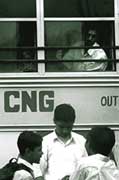 |
April:
Gunning for "clean" diesel
Delhi chief minister, Sheila Dikshit, and Union Petroleum
minister, Ram Naik, met and decided that they are on the same
side. Agreed that they cannot run the city's transport on
one fuel, that any accident in the pipeline will bring the
entire transport in Delhi to a standstill. Decided to ask
EPCA to recommend that "diesel with 0.05 per cent sulphur
is world standard clean fuel" and should be accepted
in place of CNG. "This is ultra-low sulphur diesel (sic),"
said Naik and Dikshit.
May: Private CNG buses
hit the roads
There were reports of clashes between diesel and CNG bus staff
as they both competed for passengers on the roads. As more
and more CNG buses hit the
|
|
| roads,
queues began to grow at filling stations. IGL officials kept saying
that the problem will be solved soon. |
|
|
June:
More vehicles, longer queues
The Delhi government said that the non-availability of gas could
lead to another transport crisis. It filed an affidavit in the court
saying the September 30 deadline cannot be met as MPNG is not supplying
adequate CNG. IGL promised to instal booster compressors at its
daughter stations (stations without any compressors) and convert
them to daughter-boosters (stations with compressors) by September,
which would reduce lines.
|
|
|
July:
The queues get longer
Media reports of heart-rendering stories of how
nights are spent at CNG stations in the sweltering heat were by
now common. Drivers don't see their children. Don't sleep. Don't
bathe. Lines stretch for 2-3 km. Still no action. "I think
I will leave my photo at home for my family to remember me. The
court can pass orders. But what about us," a bus driver was
quoted saying.
|
|
|
August:
The crisis deepens
August 5: Five people are injured as a Telco CNG bus catches fire.
Media, politicians and experts rush to discredit the technology
saying there are no safety norms for CNG vehicles. Next day in the
parliament, members say CNG technology is not safe or viable. Naik
tells parliament that it will take 4-5 years to increase CNG supply
beyond the existing capacity to meet Delhi's vehicle needs. "No
more gas is available physically."
Madan Lal Khurana, former chief minister of Delhi and local
BJP leader, says that central ministries, including the ministry
of environment and forests, have decided to file a joint affidavit
in the SC asking to it consider other clean fuels, including 0.05
per cent low sulphur diesel. He calls for a strike by transporters.
The inquiry report on the CNG bus fire says that CNG leakage
was not the cause, a short-circuit in the electrical system close
to the engine led to the accident.
|
|
|
August
10: Opportunistic politics
takes over. The city is brought to a halt as competing politicians
vie for public approval. BJP's Khurana leads one rally to
the SC. He says Delhi government is to blame, as it did not
inform the Centre about the "correct demand" of
CNG. Khurana and his pack tell the press that Naik has assured
them that his ministry will file an affidavit saying that
the government cannot supply gas to vehicles registered after
September 30 - the court deadline for
|
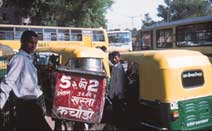 |
|
|
conversion.Congress
transport minister, Parvez Hashmi, leads the second group of transporters
to ask the Centre to supply gas. Delhi CM writes to the prime minister
asking for his intervention before a "serious law and order
situation" develops. "I draw your attention to the urgency
of ensuring adequate and reliable supply of CNG. I have noted my
concern that the Centre has not notified safety and emission norms
for CNG fuel," she writes. But her transport minister is not
convinced. He says "the recent bus blast has left us jittery.
We are not sure if CNG is a safe option."
New bait is thrown: Naik suggests that instead of CNG let them drive
on imported Liquid Petroleum Gas (LPG). CNG queues continue to get
longer and longer.
|
|
|
August
13: TERI director-general, R K Pachauri, addresses
a press conference saying that air pollution has actually increased
in the city. "We believe ultra low sulphur diesel is a far
superior option compared to CNG." The rain is responsible for
clean air, not CNG, say his scientists. Central Pollution Control
Board (CPCB) scientists refute his theory. "TERI should get
its measuring instruments properly calibrated by us," they
say.
August 16: Dinesh
Mohan, Henry Ford professor at IIT-Delhi, releases a study, this
one paid for by the Indian Oil Corporation (IOC). He says pollution
levels will go up if the SC order is implemented. "Contrary
to popular perception CNG will not reduce pollution. It will lead
to more carbon monoxide (CO), hydrocarbons and nitrogen oxides (NOx)
emissions as compared to 500 ppm sulphur diesel," says the
learned professor, whose study is based on the assumption that people
will switch from using CNG buses to two-wheelers and this will increase
pollution.
August 17: Affidavits
are filed in court. Delhi government wants the court to allow low
sulphur diesel, but it qualifies that this is only till CNG supply
becomes adequate. Wants the September 30 deadline to be extended.
Union government seeks a ban on conversion of private vehicles to
CNG. It requests the court that Euro II compliant diesel buses be
allowed in Delhi. "Now CNG and diesel options are almost comparable,
both having their own merits, with CNG buses having marginal advantage
in respect to particulate matter emissions," says the oil and
gas ministry in total disregard for scientific evidence.
The court holds firm. Rejects all affidavits, which it says must
be given to Harish Salve, amicus curiae. But is annoyed at the long
queues and inadequate supply. "We have been repeatedly told
that supply is adequate and that IGL is prepared to meet future
demands. Even today we are informed that there is no shortage of
CNG to meet the present demand as also the future demand to implement
the orders. Can you tell us who is taking us for a ride?,"
ask the judges. The court says that "there appears to be mishandling
of the CNG supply issue. The court then directed Salve "to
work out some solution." The next hearing is scheduled for
September 21 by which time the court says, "We hope we shall
be informed that proper remedial steps have been taken and there
are no queues of autos and buses and other vehicles waiting to get
CNG at the filling stations."
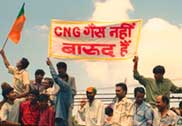 |
August
19: With the court strategy failed, new games
begin. Delhi government first announces that it will levy
a sales tax on CNG.
August 21: CM
Dikshit rules out any proposal to impose sales tax. She meets
Ram Naik once again to push for supply and safety. Naik maintains
that further registering of CNG vehicles will be a problem.
Gas supply at the national level will not improve, he says,
so LPG is a better option.
|
August
28: Khurana leads transporters to another strike.
Khurana proposes that Central government should issue an ordinance
saying that existing diesel will be allowed as clean fuel. He and
his pack of Delhi MPs meet the home minister, L K Advani, along
with petroleum and surface transport ministers. BJP sources brief
the press that the Centre has agreed to promulgate an ordinance.
August 30: The prime
minister, Atal Behari Vajpayee, convenes a meeting at his residence.
Home minister, petroleum minister and surface transport ministers
are present. T R Baalu, environment minister and, D K Biswas, chairperson
of CPCB, are also asked to join, for once. The PM takes an active
interest in the issues, say reports. Environment minister takes
a tough stand arguing that existing diesel is not an alternative.
Law minister says that an ordinance will amount to insulting the
SC.
Khurana is disappointed. The meeting rejects the idea of
an ordinance on allowing existing diesel vehicles to ply in Delhi.
Reports are conflicting. But they suggest that the only decision
is to ask the SC to allow the use of alternative fuels (but does
not agree to which fuel should be proposed). It has decided to appoint
a committee under R A Mashelkar, director-general of Council for
Scientific and Industrial Research (CSIR), to work out an auto fuel
policy.
September 5: Mashelkar
has not heard from the government.The saga continues. Read future
issues of Down To Earth to keep posted.
People have started noticing the change in Delhi's air. Peak pollution,
the highest level reached in the year, has come down for every key
pollutant
Drivers don't see their children. Don't sleep. Don't bathe. Lines
stretch for 2-3 km. Still no action
The inquiry report on the CNG bus fire says that CNG leakage was
not the cause, a short-circuit in the
electrical system close to the engine led to the accident
|
|
| Is
Delhi's air cleaner now? |
|
Central
Pollution Control Board (CPCB) data for ITOcrossing reveals that
Delhi pollution levels have not gone down dramatically, but they
have stabilised. This is because Delhi has added over 200,000 vehicles
last year. Pollution levels have actually come down in 2000 from
1998 levels for the key pollutants - particulate matter (PM10) and
sulphur dioxide (SO2). For nitrogen oxdiide (NO2), the annual peak
level has slightly increased in 2000 after coming down in 1999,
but the average levels show a consistent decline. This is only to
be expected because petrol vehicles also contribute heavily to NO2.
In case of PM10, the annual peak pollution, which invariably comes
in December, has come down by more than half.
People have started noticing the change, says CPCB chairperson D
K Biswas. "The proof of the pudding lies in the eating and
there is no better sign of the air becoming cleaner than just breathing
the air and knowing the difference." Even those visiting Delhi
can feel the difference. M S Swaminathan, a noted agricultural scientist
who lives in Chennai, during his recent visit to Delhi says the
air is a lot cleaner than before. "Only technically qualified
people or scientists or the courts can answer correctly whether
CNG is the answer to the problem of pollution. But for ordinary
Delhiites, it is a big relief as pollution has definitely come down,"
writes Mahesh Kapasi in the daily The Pioneer.
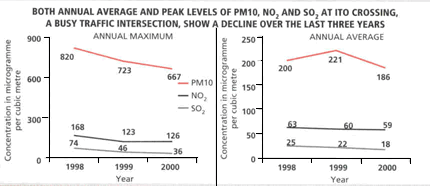
|
|





